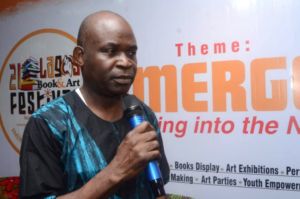
Reading certain African fiction can feel like being in the head of someone tripping on a mind-altering drug. The emphasis on sensory details—colors, sounds, tactile sensations— immerses readers in a world where perception is heightened. In these stories, anything is possible. Characters inhabit an imaginative environment where the lines separating hallucinations, dreams, mystical visions, myth, and ritual completely dissolve. In some ways, these novels challenge conventional understanding of what literature can and should do. Books I would place in this category include Ben Okri’s major writings, almost everything written by Kojo Laing, Amos Tutuola’s My Life in the Bush of Ghosts, Sony Labou Tansi’s Life and Half, Mia Couto’s Sleepwalking Land, and Unathi Slasha’s Jah Hills.
The term psychedelic was coined in the 1950s by an American psychiatrist Humphrey Osmond while, as some have pointed out, he was in conversation with the celebrated novelist Aldous Huxley, who was at the time taking mescaline trips under Osmond’s supervision. It is fitting that a fiction writer was sort of involved in the invention of the term, since fiction allows us to experience things beyond our immediate reality. The term psychedelic, a blend of the Greek words for “soul” and “manifest” means “mind-revealing” or “mind-opening.” In mid 20th century, Huxley believed in the power of psychedelic drugs to enable mystical insight into other dimensions of reality. African indigenous cultures also made space for mind-altering substances. Sinethemba Makanya, lecturer of medical humanities at Wits University, says that these substances, believed to be “dream medicine,” are used in spiritual practice: “We ingest it so we open ourselves up to receive messages. We want our ancestors to show us the path.” Today, there is certainly a psychedelic renaissance, at the forefront of which is the likes of Micheal Pollan whose book, How to Change Your Mind, has influenced the debate around the value of mind-altering drugs. But I began really thinking of African fiction in relation to altered states of consciousness after reading the essay “Literary Theory on Acid” by my dear colleague Ramzi Fawaz. I was struck by his comment:
It is fitting then that the colloquial description of a psychedelic experience as a “trip” invokes both the concept of traveling across time and space and of stumbling over an object, experience, or affective state that is enhanced to a near-cosmic scale of significance.
In the essay, Fawaz suggests that literature acts on us in ways that are comparable to how psychedelic drugs work. Literary practices of reading and analysis are designed to turn texts into shapeshifting entities that “amplify and refine” how we know and sense the world.
There is a way certain African writers talk about literature that evokes a similar mode of thinking. Wole Soyinka, in his book Myth, Literature, and the African World, points out that literature cannot simply be “the reflection of experience.” It has to be the “extension” of experience. It has to take us beyond imagining life as it is, into a space for speculation, dreams, and untethered imagination. He called these kinds of literature visionary. They go beyond mere fantasy; they push against our comfort zones and invite us to perceive the world differently. South African novelist Unathi Slasha calls for “a literature written in a ghostly language, a noisy language that captures and communicates (with) the unexplored and unlanguaged terrains.” In a recent piece in which he reminisces on writing The Famished Road, Ben Okri writes: “I wrote because I wanted to alter the inner way we saw our realities. I wanted to open up the narrow limitations imposed upon our lives.” These writers view literature as a mind-expanding experience that grants us access to knowledge, realities, and experiences beyond our familiar perceptions.
Ben Okri’s novels, particularly The Famished Road, exemplify fictional worlds depicted with psychedelic imagery. The protagonist, Azaro, is a spirit child living among humans. His condition manifests through visions in the form of endless streams of disjointed images. Acting on these visions makes him appear erratic and unstable. Since Azaro cannot explain these images and is as confused as the reader, he simply describes them, giving the story a rich visual texture. Often, Azaro encounters creatures and presences from other worlds, but on one occasion, his visions are induced by something he inhaled while lost in the forest.
And the smoke and the smells were dense everywhere and it was impossible not to breathe them in and the mysteries of burning plants in the deep forest charged my head and I went around stumbling into trees, tripping over roots, walking up against the ochre palaces that were anthills, or wandering round in circles, or watching bicycles riding around among the trees without riders, or noticing women pedaling the air without anything beneath them. Anthills which I had passed followed me. I became certain that the whole forest was moving. The trees were running away from human habitation. My eyes became charged too and I saw people with serene bronze masks emerging from trees. I saw a bird with a man’s hairy legs flying clumsily over the branches of the rain-tree. An antelope with the face of a chaste woman stopped and stared at me and when I moved it disappeared among the luxuriant bushes. An old man emerged from the anthill that had been following me. He had a white beard and green bejewelled eyes and a face that was both a hundred years old and childlike.
Scenes like these mirror psychedelic experiences where reality is suspended, and the world becomes an ever-changing series of outlandish images with no rhyme or reason, exploding with visual intensity but devoid of symbolic meaning. This passage is part of a longer sequence where Azaro wanders through the forest, observing the destruction of trees and wildlife by developers. His altered state gives him both distance and perspective that allows him to witness the violence of a dysfunctional modernity built on the deforestation of the world.
Since the book was published in 1991, Okri has become vocal about environmental degradation and climate change, which he has suggested is partly a problem of perception. He suggests that there is something about how we experience the world that prevents us from grasping how we are ruining the planet. Perhaps we need to see in a different way—a reconfiguration of the sensory and visual map of our thinking—to understand the planet’s fate. Like Azaro, we need “our eyes [to] become charged” so that we can see beyond the normalization of environmental harm into the tragic state of the planet.
Okri’s Astonishing the Gods is another example of a narrative that evokes psychedelic-like disorientation. In the introduction, Okri declares that he “wrote the book backwards in a mirror” and “inside out.” Even though he means that the book reverses priorities, burying what we consider important and foregrounding the unimportant, the idea of writing a book backwards in a mirror sounds psychedelic. He also describes the book as a quest where a character goes to unknown places in search of “a new dimension,” which again evokes a psychedelic trip.
Astonishing the Gods is more of a private, inward journey compared to The Famished Road, which is set in a recognizable world and historical moment. In Astonishing the Gods, there is no traditional narrative arc. The unnamed protagonist, after traveling for seven years to understand why he is invisible, arrives at a strange port. Hearing the voices of young girls crying throws him into inconsolable weeping until a disembodied voice tells him to stay on the island to “learn [their] mysteries,” noting that only the luckiest travelers discover the island once in a lifetime. He decides to stay, letting the ship that brought him continue on without him.
The book details his disjointed, sensory, and cognitively dissociative experiences as he moves deeper into the island. During an experience where he falls into the ocean from the mysterious flooding of a bridge, he has visions of people emerging from the water and building a city. He ends up accessing the dreams of these people and living inside their heads. This is how he describes the experience:
He had never been so happy as he was in the great dreams. His joy was so intense that he became aware of himself in the air, invisible, a pure vibration of bliss, a bird of flight. And he wondered how long he would exist in this beatification before he would find himself falling back towards the stones of a familiar reality. He had hardly completed this thought, floating above the dreams of the cultivated hills of serenity, when he felt himself falling. He was falling through the air, with the beautiful visions drifting away from him. And his fall was so strange that when he found himself on solid ground, standing there as if he had never made a single motion all his life, he was completely surprised.
The entire novel is built around this back-and-forth between intense sensory experiences of pleasure and disorientation. The character describes his emotions and physical sensations in vivid, often synesthetic terms. For example, colors convey moods and philosophical concepts, and tactile sensations are described in rich detail, immersing readers in a world where colors have taste, moods are tangible, time is sensual, and space is dizzyingly shifting. This emphasis on sensory immersion creates an emotional connection between readers and the character. As he navigate the fictional world, readers share in his awe, fear, anguish, and elation. Readers are not merely observing his journeys but are invited to feel and experience them.
Reading these books can feel like being lost in a riddle. Characters speak in paradoxes that can make the stories maddening. There was a time when I read Okri’s work trying to understand the symbolisms. I would drive myself crazy. Now, I lean into the discomfort of not understanding why one minute we are talking about “aquamarine birds” and “yellow horses,” and the next minute the character is literally breathing fire. I accept the character’s invitation to partake in his bewildering journey, feeling the same sense of disorientation and wonder. He is not asking me to suspend disbelief; he is asking me to join him in the breakdown of his reality. In an essay about a Yoruba deity who journeys through a mind-altering forest, Soyinka calls these visions “a dance of images.” Accepting the character’s invitation to join in this dance can be illuminating.
**************
Post image via Canva.









COMMENTS -
Reader Interactions